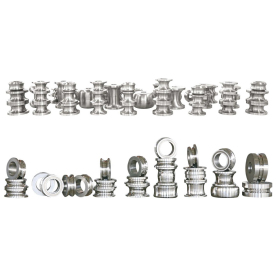In the competitive world of steel manufacturing, the ability to produce high-quality pipes efficiently is crucial for maintaining market relevance and profitability. A Complete Pipe Mill production line solution is an integrated system designed to streamline every aspect of pipe manufacturing—from raw material processing to final product delivery. This article will explore the components, advantages, and best practices for implementing a complete pipe mill production line solution, making it a pivotal consideration for manufacturers aiming to enhance their operations.
Understanding the Components of a Complete Pipe Mill Production Line
A Complete Pipe Mill production line encompasses various machinery and equipment that work in tandem to transform raw materials into finished pipe products. The primary components include:
1. **Raw Material Preparation**: The initial phase involves sourcing and preparing steel coils or plates. This stage may include slitting, shearing, and ensuring the material meets specific quality standards.
2. **Forming Section**: Here, the raw material is shaped into the desired pipe form. This typically involves several processes, such as roll forming and tube welding. The forming section is equipped with high-precision rollers and a welding machine that ensures the edges of the material are seamlessly joined.

Comprehensive Guide to Complete Pipe Mill Production Line Solutions: Enhancing Efficiency and Productivity in Steel Manufacturing
3. **Welding Section**: This is a critical stage in the production line where the formed pipes are welded. Different welding techniques, such as High-Frequency Induction Welding (HFIW) or submerged arc welding, can be employed depending on the pipe specifications. Advanced welding technology guarantees strong, leak-proof joints and adheres to industry standards.
4. **Sizing and Smoothing**: After welding, the pipes undergo sizing to ensure uniform diameter and wall thickness. This stage often includes stress relieving and smoothing processes, which improve the pipe’s structural integrity and surface finish.
5. **Cutting Section**: The finished pipes are then cut to predetermined lengths. This section typically utilizes saws or cutting machines that deliver precise cuts while reducing waste.

Comprehensive Guide to Complete Pipe Mill Production Line Solutions: Enhancing Efficiency and Productivity in Steel Manufacturing
6. **Inspection and Testing**: Quality assurance is integral to pipe manufacturing. This section involves rigorous testing for structural integrity, dimensional accuracy, and surface quality. Non-destructive testing methods, such as ultrasonic or X-ray inspection, are often employed to identify any internal defects.

Comprehensive Guide to Complete Pipe Mill Production Line Solutions: Enhancing Efficiency and Productivity in Steel Manufacturing
7. **Packaging and Dispatch**: Once the pipes pass inspection, they are cleaned and packaged for delivery. Automation systems may be used to optimize this process, reducing handling time and enhancing safety.
Advantages of a Complete Pipe Mill Production Line Solution
Investing in a Complete Pipe Mill production line solution offers numerous advantages critical to competitive steel manufacturing:
1. **Enhanced Efficiency**: The integration of various stages of production into a single line reduces the time required to manufacture pipes. Automated systems streamline the workflow, reduce manual labor, and minimize downtime.
2. **Improved Quality Control**: With all processes occurring in a controlled environment, manufacturers can maintain stringent quality standards. Real-time monitoring ensures any deviations are quickly addressed, maintaining product integrity.
3. **Cost-Effectiveness**: By optimizing production processes, manufacturers can significantly reduce waste and operational costs. The economies of scale achieved through a complete production line can lead to substantial long-term savings.
4. **Flexibility and Customization**: A complete pipe mill production line can be designed to accommodate various pipe specifications and materials. This flexibility allows manufacturers to respond quickly to market demands and customize products to meet specific customer needs.
5. **Data Integration and Automation**: Many modern complete pipe mill solutions incorporate advanced technologies such as IoT (Internet of Things) and AI (Artificial Intelligence) for data collection and analysis. This digitalization enhances decision-making, predictive maintenance, and overall operational intelligence.
Best Practices for Implementation
When considering the implementation of a Complete Pipe Mill production line solution, manufacturers should adhere to best practices:
1. **Conduct a Comprehensive Needs Assessment**: Evaluate current operations, production goals, and market trends to identify specific requirements for the new production line.
2. **Select the Right Technology and Equipment**: Invest in high-quality machinery that meets industry standards and is compatible with your production requirements.
3. **Train Employees Thoroughly**: Ensure that all staff are well-trained in operating the new equipment and understanding the entire production process efficiently.
4. **Monitor and Optimize Performance Continually**: Implement a system for monitoring production metrics and regularly assess the performance of the line. This allows for continual improvements and optimizations, ensuring maximum efficiency.
5. **Focus on Sustainability**: Modern pipe mills should also consider sustainable practices, such as waste reduction techniques and energy-efficient machinery, to meet environmental standards and enhance corporate responsibility.
In conclusion, a Complete Pipe Mill production line solution is pivotal for maximizing the efficiency and productivity of steel manufacturing operations. By investing in state-of-the-art technology, focusing on quality control, and adopting best practices, manufacturers can ensure they remain competitive in a challenging market landscape.Automatic Solid state HF welder



